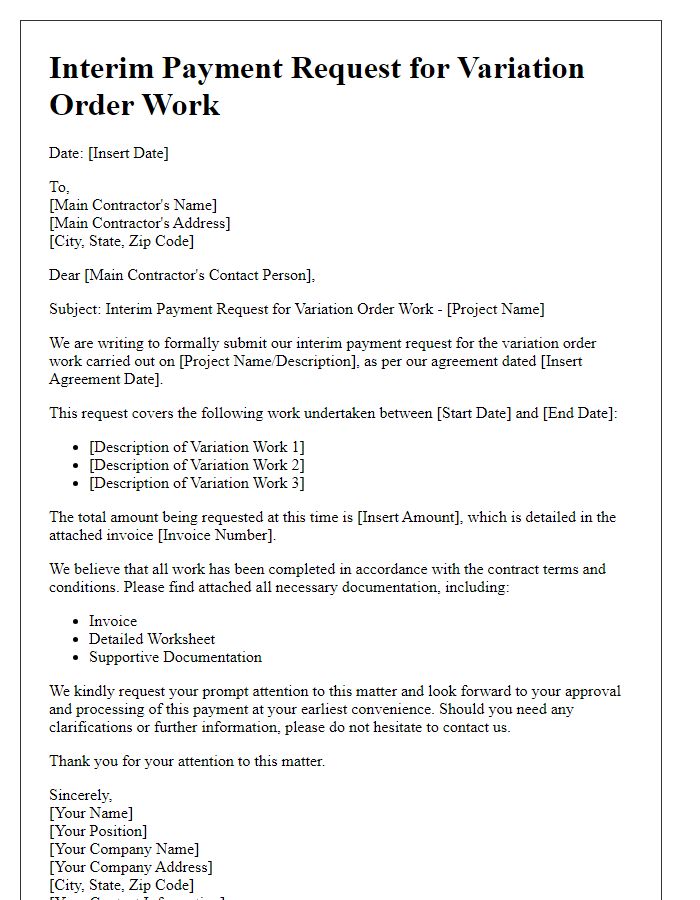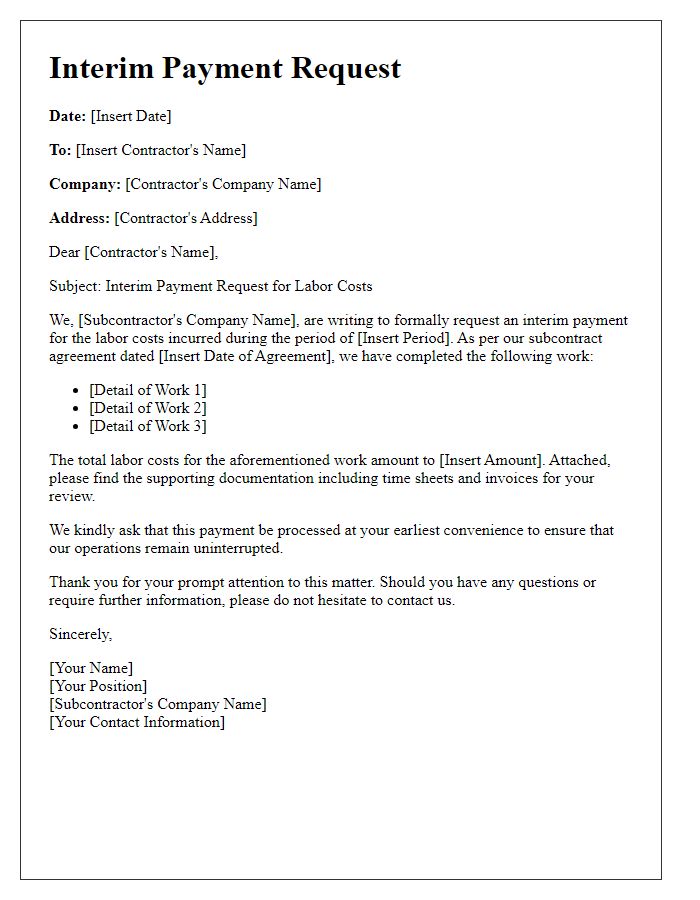Are you navigating the sometimes tricky waters of subcontractor payments? Writing an interim payment request letter can be daunting, but it doesn't have to be! In this article, we'll break down the essential components of an effective letter to ensure your subcontractors receive timely payments. Stick around for tips and a handy template that will make your payment requests a breeze!

Header Information: Contractor's name, subcontractor's name, project name, and contact details.
A subcontractor interim payment request requires precise header information to ensure clarity and proper processing. The contractor's name should reflect the primary entity overseeing the project, such as "ABC Construction Group, Inc." The subcontractor's name must specify the individual or entity performing the work, such as "XYZ Electrical Services, LLC." Including the project name is essential, e.g., "Downtown High-Rise Development," providing clear context for the work executed. Contact details must encompass the contractor's and subcontractor's addresses, phone numbers, and email addresses, crucial for communication and follow-up regarding the payment request.
Payment Details: Invoice number, payment amount requested, and payment period.
Interim payment requests from subcontractors provide crucial information for processing payments in construction contracts. Invoice number serves as a unique identifier for each transaction, facilitating easy tracking and reference. Payment amount requested details the financial sum that the subcontractor is seeking for completed work, labor, or materials provided during the specified timeframe. Payment period specifies the dates during which the services were rendered or materials were delivered, ensuring both parties have clarity regarding the billing cycle. Accurate documentation in these categories ensures prompt and correct compensation for subcontractors and fosters smoother financial operations for construction projects.
Work Description: Summary of work completed to date and any milestones achieved.
Subcontractors play a vital role in large construction projects. Clear documentation of work completed is essential for interim payment requests. The work description should detail the specific tasks performed, such as framing, plumbing installations, or electrical wiring, along with measurable milestones, such as the completion of the foundation by a certain date or inspection approvals received from local authorities like the building department. A summary should specify the percentage of the project completed, such as 70% of the total electrical work, based on the original contract terms, which were agreed upon on the start date, June 15, 2023. In addition, identifying any challenges faced during the process, such as delays due to adverse weather conditions or supply chain issues, can provide clarity and support the necessity for requested payments.
Supporting Documents: Attachments such as timesheets, receipts, and progress reports.
Interim payment requests submitted by subcontractors often require a comprehensive set of supporting documents to validate the claim. Key attachments include detailed timesheets that record hours worked by the subcontractor employees, specifying labor costs over the billing period. Receipts for materials purchased, including itemized costs, provide evidence of expenses incurred during the project phase. Progress reports give insight into the milestones achieved, showcasing completed tasks, project advancements, and alignment with contractual obligations, often reflecting a percentage of project completion. Ensuring all relevant documentation is meticulously organized enhances the likelihood of timely payment processing by the primary contractor.
Payment Terms: Payment schedule, due date, and accepted payment methods.
Subcontractor interim payment requests often involve a structured payment schedule, clearly defining due dates and acceptable methods for transactions. A typical payment schedule might outline specific milestones, such as completion of phases in a construction project, with payments distributed accordingly (for example, progress payments released every 30 days). Due dates generally align with invoicing dates, ensuring timely settlement of accounts, often set within 15 to 30 days after invoice receipt. Accepted payment methods usually include electronic funds transfer (EFT), checks, or bank wire transfers, highlighting the importance of efficiency and tracking in financial transactions within the construction industry. Distinct guidelines streamline the payment process, preventing delays and fostering trust between contractors and subcontractors, essential for continuous project progression in places such as Los Angeles or New York City.
Letter Template For Subcontractor Interim Payment Request Samples
Letter template of subcontractor interim payment request for completed work

Letter template of subcontractor interim payment request due to project milestones

Letter template of subcontractor interim payment request for additional expenses

Letter template of subcontractor interim payment request following assessment

Letter template of subcontractor interim payment request with supporting documentation

Letter template of subcontractor interim payment request for variation order work

Letter template of subcontractor interim payment request at contractually agreed intervals

Letter template of subcontractor interim payment request addressing delays

Letter template of subcontractor interim payment request regarding labor costs





Comments